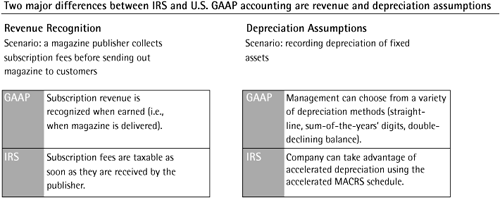Deferred Taxes
The income tax expense that a company records on its income statement in accordance with Generally Accepted Accounting Principles (GAAP) does not always equal the taxes a company actually owes to the IRS.
| Debit | Credit | |
|---|---|---|
| COGS (SE)[1] | 5 | |
| Inventories (A) | 5 |
[1] Sometimes companies disclose large write-downs separately on the income statement; other times they include them in COGS.
For the purposes of reporting financial statements to the public (via the SEC), companies prepare their financial statements in accordance with U.S. GAAP. Companies trading in exchanges outside the United States may report in accordance with the GAAP of their respective countries. Under GAAP, tax expense is calculated based on the GAAP pretax income.
Source: Used with permission. Microsoft 2005 Annual Report.
However, in addition to reporting these financial statements, companies must also prepare financial statements to the IRS for filing tax returns. The differences (Exhibit 6.4) between GAAP tax expense and IRS taxes payable are recorded as deferred tax assets and liabilities.
Advanced Discussion: Deferred Tax Asset
A deferred tax asset is created when taxes payable to the IRS are higher than those recorded on financial statements (Exhibit 6.5). Deferred tax assets therefore represent potential future tax savings.
Exhibit 6.5. A Deferred Tax Asset is Created When Taxes Payable to the IRS are Higher than Those Recorded on GAAP Financial Statements

Some typical causes of deferred tax assets are differences between IRS and GAAP revenue recognition rules, warranty expenses, and tax-loss carryforwards.
The cost of restructuring is recognized on the income statement when restructuring is known, but is not expensed for tax purposes until the costs are actually paid.
The write-down of impaired assets is recognized for financial reporting, but not for tax purposes until the assets are sold.
Other expenses that generate deferred tax assets (or liabilities) include inventories due to different inventory accounting methods such as LIFO, FIFO, and average costs. In addition, restructuring and impairment charges often result in a deferred tax asset:
Other current assets is a catch-all category that includes miscellaneous current assets, such as:
Short-term investments
Prepaid expenses:
Represent operating expenses that have been prepaid by the company in advance for services it is yet to receive. Such operating expenses include:
Insurance premiums,
Property rents, and
Salary advances.

Property, Plant and Equipment (PP&E) represents land, buildings, and machinery used in the manufacture of the company’s services and products, plus all costs (transportation, installation, other) necessary to prepare those fixed assets for their service (Exhibit 6.6).
Exhibit 6.6. PP&E Represents Companies’ Land, Buildings, and Machinery (i.e., Fixed Assets)
Source: Used with permission. Microsoft 2005 Annual Report.
PP&E is linked to depreciation on the income statement. Recall that depreciation is the systematic allocation of the cost of fixed assets over their estimated useful lives; PP&E represents those fixed assets. Suppose depreciation expense in Year 1 is $100. Its effect on the balance sheet (a decrease in PP&E) can be illustrated through credits and debits:
| Debits | Credits | |
|---|---|---|
| Depreciation Expense (SE) | 100 | |
| PP&E (A) | 100 |
PP&E is also referred to as
Fixed assets
Tangible assets
IFRS Perspective: Historical Cost and Revaluation of PP&ERecall that U.S. GAAP requires most balance sheet items, including PP&E, to be recorded at their historical (acquisitions) cost. No upward revaluation is allowed. Under IFRS, certain assets, including PP&E, are allowed to be revalued. If companies choose to revalue their assets, regular revaluations are required. |

